Growing luffa sponges
So, you want to start growing luffa sponges? You’re in the right place! This is a step-by-step guide on how to grow these natural luffa sponges.
Luffa sponge (also spelled luffah or loofah) is a cucurbit vegetable in the gourd family. They actually can grow right in your backyard! I always thought they were sea sponges from the ocean! These gourds are most used as scrubbing sponges due to their porous fibers that soften when wet.
Also known as dishrag gourds, sponge gourd, vegetable sponge, Egyptian luffa, Egyptian cucumber or their scientific name, luffa aegyptiaca and luffa cylindrica, these multi-use sponges are so much fun to grow.
There is another type of cucurbitaceous vine commonly grown for its unripe fruits as a vegetable, luffa acutangula. These luffas have an angled outer shell. They look just like the smooth luffa plants we will be discussing today, but with ridges. Ranging from Central, Eastern and Southeast Asia, they are grown as houseplants in colder climates! Some of their common names include Chinese okra, dishcloth gourd, ridged gourd and silky gourd.
Although some folks eat luffas as young fruits like squash or cucumber would, I won’t be doing that. Instead, I’ll be hanging them to dry to use as biodegradable sponges and will teach you to do the same! Are you ready to grow these natural scrubbers?
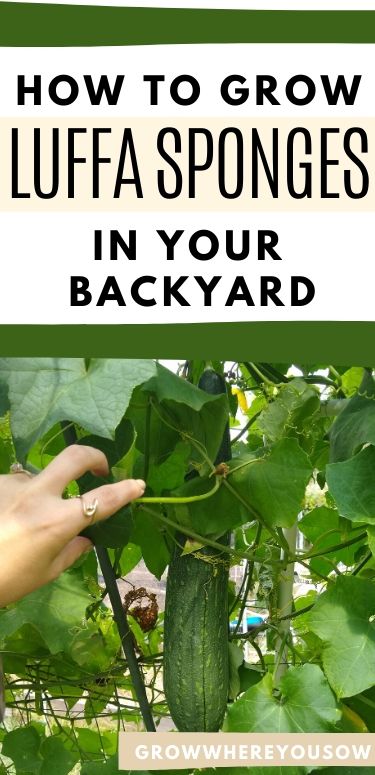
Table of contents
How to start growing luffa sponges in your backyard.
When growing a loofah sponge, it doesn’t have to be hard. Many folks find it easy, super fun and rewarding! Harvesting them can sometimes be a challenge, but I’ll walk you through that, too. I’ll take you through my process and we’ll find yours as well. You’ll be growing loofah sponge after loofah sponge in no time.
Don’t forget to read the comments for other folks’ quick tips and experiences!

Where to get seeds: The First Step
I learned about growing loofah plants from someone writing about how challenging it was. Well, a challenge sounded good so I bought some seeds.
I remembered reading the luffa seeds would take a very long time to germinate, but mine only took tops two weeks! Once I bought the black seeds and put them in the ground, they popped up almost immediately. No soaking or chilling required!
Of course, I am in Central Florida where we have plenty of frost-free days and a very long growing season.
Soil and location
You should use rich, well-draining soil. There is sandy soil here in West Central Florida so I was sure to mix in some quality, home-made compost.
Paired with the rich humus and nutrients from the compost, I had the perfect ratio of sand:soil to grow this tropical plant without much effort.
For the location, your vines need lots of sun exposure, a sturdy trellis and a lot of space! My luffa vines get sun all day long and they love it. You want to make sure your sponges grow on a sturdy loofah trellis so the 1-2 foot (Yes, you read that right!) gourds don’t rest on the ground to rot.
I set mine up by a fence and they took off and took over! Here’s a picture of how they started out. (This picture was taken June 27, 2018, and the seeds were planted May 17, 2018!):
This vining plant started producing fast-growing vines before I could say “Uncle!” (that’s the saying, right?).
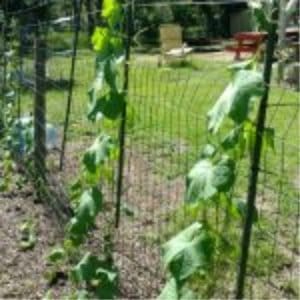
Watering your gourds
I live in Florida so we get a fair amount of warm water from the rain. I’ve turned my hose on a total of 10-15 times since May! Needless to say, our electric bill has been low all summer because we haven’t had to use our well quite as much. Thanks, Mother Nature!
On dry days, I give the base of the vines a nice soak so I can maintain a consistent schedule for growing. I’ve also mulched them since the rain is slowing down a tad bit here in September. My luffas are thriving!
In colder climates where rainfall is less, you may have to water your plants more often. Regardless of your zone, water the base of the plant and not the vines of the luffa plant, male of female flowers or gourds. Saturating these can lead to the development of powdery mildew or downy mildew, dark spots on your gourds and rotting luffa fibers.
If your luffa seeds get waterlogged, they won’t survive. So if your yard puddles after rains then you can do yours in pots! Make sure to have a good, strong trellis for them. By August 3, 2018, my vines looked like this:
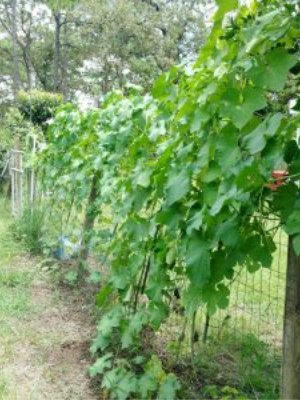
This looks all fine and dandy but I read that vines can grow up to 30 feet! When I started growing these fun sponges I didn’t believe it at first but proven wrong. Don’t worry, I’ll show you a picture! The twine strung between the posts was pulled by the weight of leaves and thick stems.
Next year I’ll construct something out of wood and wire.
The perfect season for growing a luffa sponge
Luffas love hot weather and a long growing season. They can take around 4-5 months to reach maturity so I’m nearing that date now. Planted in mid-May, I’m at the four-month mark.
I got my first bloom on August 13, 2018, and boy was it pretty. Soon after I got my first bloom, I noticed my first gourd. The gourd is high up in a nearby lemon tree.
Below you’ll see my first flower, my first gourd, and how intense the luffa vine took over. I love them and they love the luffa flowers so I’m totally okay with the bee party that takes place every day all day.
I’ll miss them when they go but look forward to the next year. If bees aren’t your thing, don’t plant luffas or plant them somewhere that you don’t have to pass by so often.
Just because luffa plants and luffa fruit love warm temperatures, that doesn’t mean folks in cooler climates can’t grow these natural sponges. For folks in a lower hardiness zone with shorter growing seasons, your luffa will take longer to mature. Plant them as soon as you can after the danger of frost has passed. Always know what your projected first frost and last frost date is and get them in the ground as soon as the risk of frost has passed.
Sow the seeds in a sunny spot with good drainage, and mulch them to aid in warm soil and good germination. If you wanted to get a head start on growing your own loofahs, you could start them in large pots with well-drained soil and transplant them once they have established sprouts, before their first flowers arrive so you don’t shock them.
Alternatively, you could start your seeds in a dark place, transplant them into large pots and just move the pots outside once the cold temperatures have passed, keeping an eye on the immature fruits with green skin just in case. This allows you to take advantage of the entire growing season, and then some.
Under the right conditions, germination rate will be high and you’ll have yellow flowers turning to green luffas turning into mature luffa gourds in no time.
Pests
I didn’t experience any pests on my crop, but some folks have mentioned cucumber beetles. These beetles are a common species in home gardens and become active in late May or early June, making them a perfect pest for luffas. They feed on the blossoms of early flowering plants!
Keep an eye out for these yellow and black beetles and manage them swiftly. This is a great article on ways to battle cucumber beetles.

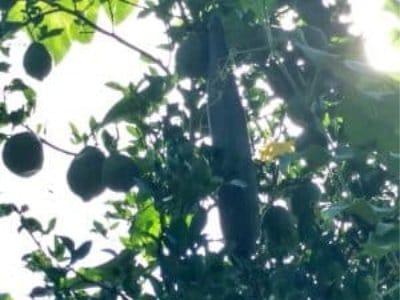
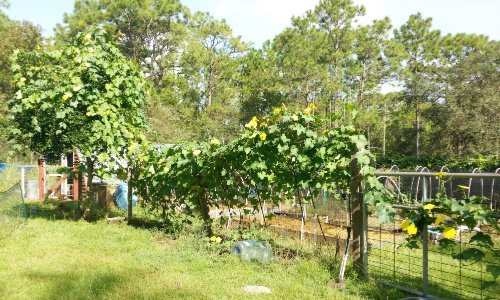
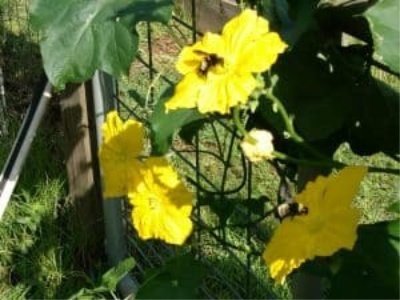
Harvesting and drying: The Final Step
I’ll be harvesting my luffas soon. Some say to wait until they have dried and developed brown skin and others say to harvest and peel them once the skin feels “loose”.
Considering the zone you’re growing in, your mature gourds will need to be harvested at a different time.
After I peel my luffa gourd, I’ll remove the seeds, spray off any pulp, let them soak in a soapy water or vinegar water and then dry a couple of weeks.
These gourds were supposed to be a difficult vegetable to grow. They worked out flawlessly in my yard! For us Floridians, our long growing season supplies us with a great opportunity and a greater chance at growing tropical crops.
Here’s a quick video of the first time I harvest my luffas! They were a little too brown, but it still worked out nicely.
To summarize:
Once the outer shell is removed, this fibrous sponge can be used in homemade soaps, at the sink to clean dishes and in the bathroom to clean your body. Here are some DOs and DO NOTS as a recap. Good luck and I am wishing you the most plentiful growing season!
DO:
- Plant your luffa seeds in a well-draining, sunny area.
- Construct a strong trellis to support your vines all seasons.
- Admire all the bumblebees you’ll attract; it’s a truly great thing.
- BE PATIENT! Once you see that first bloom and gourd, it’ll take off from there
- Tell me if you’re growing luffa gourds so we can chat about it!
- Send me pictures of your vines!
- Read this next as a follow-up post: Harvest Luffa Sponges: How to and When to Harvest!
- Use your luffas for dishes because it’s the best!
- Read the comments below to see other folks’ experiences and comments.
DON’T:
- Harvest them too early.
- Shade them because the flowers close, this is normal.
- If you’re scared of bees, plant them near the house.
- Plant them on a fence that is already falling apart… I guess I’ll finally be fixing the fence after the season is done!
- Plant them too close to other vegetables such as squash. They might cross-pollinate!
- Overwater them. Remember, waterlogged seeds mean no germination!
POST UPDATE:
For those of you who have been following this blog for a while, you’ll know I was originally based in Florida. I have since moved to Eastern Kentucky – which is a whole new gardening ballgame! I’ve completely started over and have been slowly building up a brand new homestead.
This blog will continue to be a safe learning space – and I’ll continue to write transparently about the new experiences I have. FIRST OF WHICH will be growing loofah gourds next season! I’ll need to source some loofah seeds and get started by late March, and that is so exciting!
For those of you who need guidance on growing this climbing plant in a cold climate, I am here for it! And soon I’ll be able to give personal advice on growing luffa sponges in cooler climates. I. AM. SO. EXCITED. In the meantime, drop me a line and happy growing!
Don’t forget to pin this for later!

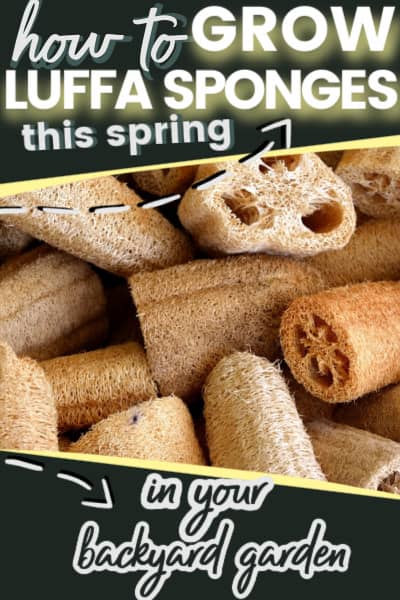
Since we are getting a frost really soon, I went ahead and picked the loofas. They are still green. Should I wait for a bit before I peel them?
Hi, I started my seeds in May. I have my first bloom today (June ) but I noticed some bugs…ants and possibly aphids. What do you suggest to use so I don’t hurt my plants?
And thanks for the great info! I can’t wait for them to mature!
I need some luffa advice Chelsea! I have my luffa plants growing in 2 areas of my yard. One area has THRIVED and now taking over my back porch! (we just love the new living wall it has created)! The plants in the other area have not thrived as much. They are growing but minimally compared to the first area described. But the under developed plants have a few flowers on them (YAY), and the thriving plants do not have any flowers yet. I figured it would be the other way around. Do I need to fertilize the thriving plants so they will start to bloom as well? I have done nothing but water them when it hasn’t rained for a few days (which doesn’t happen often in NE FL during Hurricane season). I am worried, as if my child had fallen behind in school. Thanks for any advice you can give me!
Hi Diana, my apologies for this late reply. I wouldn’t fertilize the plants. They can be slow to bloom but, once they do, they should take off! Just be sure they don’t overcrowd each other and you don’t overwater them. I hope this helps! Good luck to you and stay safe!
This is my first year growing luffas in my NE FL garden. I started them in a pot on back porch and transplanted them in 2 areas. One area has grown, but not thrived. The ones I planted in my raised bed garden next to my back porch…we’ll they are growing up my blinds, onto my roof, and onto my porch furniture! I had no idea they would be so enormous! No flowers yet, but I am expecting some soon (planted seeds in early May). I wonder if I move the ones that have not thrived, if they would take off and provide another batch later in the season? Thanks for all your info on these really cool plants!
We are in our second year of growing luffas here in coastal South Carolina. I would love to share pics but don’t see that option. What started as an experiment of curiosity when school closed last year turned into a lot more. We’ve shared seeds and sponges with teachers, classmates, my hairdresser, and even strangers. We’re trying to figure out a better trellis/growing combination for next year.
I am about to plant my first luffa in southern AZ, so I think we have plenty of sun and warmth. What I was wondering and cant seem to find the answer is……. Are luffa deer resistant? will determine where I plant them. Any insight will be much appreciated.
Hi Brian! I’m so excited for you that you’re growing luffas. As for the deer, I haven’t personally had to deal with them but I would say always better safe than sorry. If you have a spot safe from deer, plant the luffas there! Luffas are an edible crop so I just have to assume that a deer might like to nibble. Good luck!
Hi!! I got some seeds from a co-worker planted on the west side of my house and it’s been about two Weeks into February inside greenhouse once it grew nice roots I planted in yard. It’s doing great about 2-1/2 feet tall get nice wines. Should I fertilize? If so what do you recommend? Thank you also it’s almost like it’s dry everyday so I lightly water. Just nervous I’ll over water or under water lol what do you think? I’m in Florida as well Clearwater area
Hi!! This is my first year. I am in NC and expect a freeze tonight so I picked 24. 1.5 to 2 foot long gourds. I plan on drying them out in the basement but is there something special I should do like turn them up? Also mine grew up a tree a bit and some cracked a bit when they fell. Are they a loss cause. Should I peel them now and hope for best. Still very green. Thank you and loved reading you page.
Hello Rachael! How exciting that you harvest 24 sponges! I’m not sure what you mean by turning them up. Could you explain? The ones that fell and cracked I’d probably go ahead and peel them and wash thoroughly and hang dry them unless you’ll be able to check them in the basement often to make sure they’re properly drying and not growing mold. I’ve never dealt with frost, but have done lots of reading and speaking with folks in your position. Leaving them in the skin to dry is an option, as well as peeling them while they’re green. Just remember to wash them very well, getting all the sap out. Since you have so many, you could also A/B test and leave some and peel some. Check out my article on Harvesting Luffa Sponges and read the comments, also. Folks have shared some similar situations that you’re in recently. https://growwhereyousow.com/harvest-luffa-sponges/ Good luck and feel free to reach out with any more questions!
Hi there, I just grew this lovely plant for the first time in On, Canada. I had planted them after fear if frost and my 2 plants stretch over 20 feet, tons of flowers but few gourds. One is roughly 2.5 feet and I was wondering the skin isn’t quite loose, if I should pick it and see how many more grow before end of season (coming soon!)
Hello
Thanks for all the info. I am a first timer growing these. I just picked my first one to test if they are ready. It seems firm and was turning to lighter green. I picked and peeled and washed off the residue. However , it has a light green hue to it. Will it lighten as it dries out or did I pick to early ?
Hi Rachael! As the luffas dry, they’re definitely going to get lighter. If you picked them early and are choosing to let them dry in their skins, keep an eye on them to make sure they don’t start to get mold or mildew. Good luck to you, my friend!
Hi! I live in Northern Ohio and grew luffah for the first time this year. I planted seeds in the beginning of June and they germinated in about 10 days. I was so excited!!! It grew so fast I couldn’t believe it and my soil isn’t best. I got around 12 gourds out of 12 plants. Could be better but I’m happy for that. I had to pick them when they still green because of an early frost in my area. When I picked them green (but fully grown) I give it a squeeze and started peeling them. What a nice sponge was inside!! I washed them and squeezed all the seeds in the bucket of water. Seeds were still white not quite ripe and I couldn’t save them for next year. Then I put the clean sponges in the dryer. It took about 1/2 hr for them to dry. I cut them into my desiring sizes and absolutely love them. Will grow them next year for sure. My favorite plant to grow on my homestead so far and so useful. My skin love it!! My dishes adore it!!
Hi Nadia! That is so awesome! Luffas are so much fun to grow and what a great idea to dry them in the dryer! I love doing my dishes with luffa sponges, too. They’re my favorite for dishes! Thank you so much for sharing your experience with me, Nadia! Good luck to you in all your gardening endeavors!
Growing in NC. My bottom leaves look like their dying but the top continues to grow. Can’t tell if I’m over watering or under. It’s been in the high 90’s for weeks here. Help!!!
Hi Erin! Luffas are usually very heat tolerant so I’m going to assume that the problem is watering. Here’s what I do in my gardens in Florida. When I wake up in the morning, I stick my index finger in the soil and if it’s moist, I don’t water. If it’s dry, I water thoroughly. I always water BEFORE 10 am because any later than that it is very hot and the sun is blazing. You could also look on Amazon for a water gauge that might help. Another option is to water with a watering can so you have more of an idea on how much water your luffas are actually getting. Outside of that, if you start watering consistently and the problem doesn’t go away then you might have a vitamin deficiency. I hope this helps!
I saw a luffa plant for the first time at our Virginia State Fair last fall and I fell in love with the plant!! This will be the first time I try to grow it. A neighbor said to wait until it’s consistently 60 degrees or higher and we are finally reaching that so I am planting mine tomorrow!! Can you believe it froze end of April early May here. So unusual! It was hard to find seeds. I ended up ordering off Amazon. How many luffa’s do you usually get on one plant? And how many seeds do you plant in one spot? 4/5? Thank you for any help!!! I am new at gardening, this is my first year.
Hi Lisa!
Aren’t the luffa plants awesome!? Your neighbor gave you great advice – luffa plants love warm weather. I planted my seeds about 1 foot away from each other and I can’t remember completely, but I think I got 6-10 gourds from each separate vine. I’m SUPER late planting mine this year and will actually be trying them in containers this year! I’m so glad you started gardening – I think everyone should try to garden once in their life. I hope you love it! The weather down here in W. Central Florida has also been very strange. It was COOL yesterday morning but two days ago I was outside at 8am and SWEATING! Crazy stuff, for sure. Well, I wish you the best of luck with your luffas and any other crop you grow this season. Feel free to keep me updated on your progress! Thanks for sharing with me, Lisa!
Hi,
I have been growing Loofahs for a few years. I live in the California desert. I also use our own compost. I don’t think you always need a trellis. You can plant near a hearty tree. I use my palm trees and big plumeria trees, citrus trees. I also choose to wait til they dry on the vine. It just to me makes more sense. I think it’s just a preference. It is messy but since we compost it really is just fine. And each loofah give so many seeds. It’s like a gift that keeps on giving. I also agree with the flower comment. I just love the pretty yellow flowers and the bees oh…so amazing.
Hello from Florida, Heather!
I agree you don’t always need a trellis, but some folks don’t have a hearty tree like you and me! I was lucky to have planted my luffas next to the pig citrus tree in the pictures above. It definitely acted as a trellis! If I were to plant my luffas in any other part of the yard, though, a trellis would be required. It absolutely depends on the person’s situation and resources, for sure! I waited for a few to dry on the vine and they actually turned black. I’m in W. Central Fl. so, again, this really depends on the climate and type of season in the specific area. What worked best for me was to pick them a little early before totally dry, peel them, spray them, and let them dry on their own. A little more labor-intensive, but it’s what worked for me. Yes, each luffa really does give so many seeds! It’s amazing! I’m late this year on getting mine in the ground but I can’t wait to see the beautiful flowers and bees come back! Thank you for stopping by to let us know what works for you. It’s so wonderful to hear how other people grow the same crops because it really is often a preference, climate, and resource-driven. Let me know how your luffas turn out and stay safe! Cheers. -Chelsea
How many seeds did you plant? I have 2 pots with 2 seedlings each with this being my first year. I have limited trellising so trying to figure out if this is too many.
Hi Sue! I believe I planted 6 seeds and they all came up. I had a high quantity of luffas! Each plant will need to be trellised. If the trellis is sturdy, you could probably use one trellis for multiple plants. That depends on the size and sturdiness of the trellis, though. Additionally, depending on the pot size, you might want to thin them back to 1 seed per pot unless your pot is large enough to properly handle 2. Regardless, if you do thin back to 2 plants I think you should end up with a nice luffa harvest at the end of the season! Good luck and keep me updated. Let me know if I can answer any more questions. Stay healthy! -Chelsea
I planted two seeds, produced over 100 Luffa’s this year. They grow fast. Would send you a video but do not see tgat option here.
How old is too old for seeds?
Hi Terri! Great question! It’s a slightly complicated one to answer because it all depends on how you’ve stored your seeds over time. Many seeds can be viable up to 2-6 years if stored in the correct way consistently. Certain crops, such as corn or peppers, are best planted within the 2 year mark as their chance of survival decreases after 1.5-2 years. For crops such as beans and tomatoes don’t do so well after 4 years and lettuce and cucumber seeds can be viable for up to 6 years. Be sure to store your seeds in a dark, cool place always. I used to leave my seed box in the shed and quickly realized my gardens weren’t growing because the seeds were in bad shape from the constant temperature swings here in Florida. If the shed had been temperature controlled, I would’ve had a better chance. I hope this helps! The great thing to know is that planting old seeds won’t hurt your garden, or the plant if it grows. Good luck to you and thanks for stopping by!
I was wondering since I picked my luffah sooner then I should have…. The seeds are still white. Is it worth planting them or just throw them away?
THanks!
Diane
Hi Diane! I’m not sure I completely understand your question. You feel you picked your luffahs too soon and the seeds are white? What does the inside of the gourd look like when you peel it?
Hi, loved your article! I have been growing lufa’s this year for the first time, and I love it.
I grew mine in a pot to start out, then transplanted them into the ground. I used parts of an old gazebo frame with wire for the vines to crawl out on. It has worked out real well.
When picking I waited until the vine on the top of lufa was brown to pick mine, I waited a day or so before taking the opposite end off and then shaking them in a bucket to catch all the seeds. I then soaked them in water about an hour to remove the outer hull, I rinsed them in cold water then hung them to dry.
The only thing I have wondered about is the thickness of the lufa itself. Ones I have seen in the store are thicker, mine however are not.
I’m wondering if your lufa’s were thick or thin, and if they were thick, do you think it was the seeds you bought that helped?
As an after thought, with all the lufas I have gotten and the ones still growing I could strat a lufa farm!🙂
Hi Michele! I’ve never tried transplanting them, that’s awesome it worked! I’ve read about luffa farms and think it’s awesome! Let me know if you ever start one. Thanks for stopping by and talk soon I hope!
I live in SW Iowa ,started the seeds from bakers early under gown lights in the shed ,planted them in the grown after it got warm enough they was about 1-2 feet tall by then ,they took off like crazy the vines are amazing , here it is in Sept. not 1 luffa , what is my problem please I did notice yesterday I got a couple of buds but they wont grown that fast that id get any would they its been over 130 days ,im so unhappy about this we don’t get a lot of rain in our area so I know they didn’t get to wet , thank you any advice would be helpful
Hi Barb! My luffas took a VERY long time to start growing actually luffa vegies/sponges. I would say to make sure you’re watering consistently and give the vines time. Even watering is very important and it’s better that they’re a little wetter than they are dry, in my experience. If for some reason it doesn’t work for you, next year make sure they’re getting consistently watered and possibly try starting them even earlier inside before transplanting. But for now, I’d say to just stay patient! Buds are a great sign! Good luck to you and let me know how it goes. Gardening is often trial and error.
Thanks for the article. I was wondering what was the easiest way to get the seats out without damaging the luffa
Thanks for sharing
I let dry just enough to where the seeds actually dry out in there, and then you just shake them right out! Before you cut into the luffa it’ll sound like a rattle when you shake it. Good luck, Gina!
Started growing the luffa last month. No flowers yet. I read somewhere you are suppose pick off the first set of leaves so that you get more vines( flowers) have you heard if this? I Just put up a high dome hot house would this be enough lite for the plants. Thank u in advance for the info
Hi Valerie! My plants took quite a while to flower and I did NOT pick off the first set of leaves. My vines grew an amazing amount of luffas, more than I could believe! Make sure they’re watered and weeded and wait for those flowers. When mine started to flower, they really took off. Luffas do need full sun. Mine had sun all day long and thrived. BUT that doesn’t mean it’s not possible for them to grow with partial shade, all crops and areas are different. Remain patient and wait for those beautiful yellow blooms. They’ll come! Good luck and keep me updated if you think about it! Thanks for stopping by, Valerie!
I just bought 2 little luffa plants about 4 days ago, they are sky rocketing! you have covered every question i had about growing them, thank you for being so informative and helping me with my first time growing luffa !!
Oh, Dunia, that is such great news! If you think about it, feel free to keep me updated. I’m so glad this post helped and good luck to you!
Well…this was a fun article!
I’ve never grown luffas, but you’ve gotten me interested.
And I wonder what you’ll DO with all of those luffas? They look huge! I didn’t catch it—do you cut them down to a more manageable size? They look pretty cool how they are!
Thanks for the post.
Found you on the Oak Hill Homestead blog hop.
Hi Laurie! I’m so glad you liked the article. Growing luffas is SUPER FUN to do. I suggest everyone does it if they have the space!
I actually wrote about what to do with luffa sponges (here’s the link —> https://growwhereyousow.com/2019/02/11/luffa-sponge-uses/ ). My husband uses a whole luffa sponge to bathe with. I cut them down to the size I want. I use one to exfoliate my face at the sink, another one for my feet in the shower, and I wash my dishes every day with a luffa sponge! There are so many uses! If you grow them, let me know how it goes. I’d love to know! Thanks for stopping by and participating in the hop!
I have grown different gourds before but this want to try luffa. Will let yo know how it goes. Found you on Simple Homestead Blog Hop.
PLEASE DO let me know, Candy! I can’t wait to grow them again this summer. I’ll be putting up a sturdy trellis soon!(: Thanks for stopping by!
This article was just what I needed! A teller at Home Depot have me 20 seeds and ALL are growing quickly. However, they are all inside. I live in Queen Creek Arizona & I am terrified to put them outside for fear of the heat. They are 3-4″ lomg. When would you suggest I take them outside to transplant? Thank you in advance for the help. You’ve got me motivated!
Hi Laura! I can not imagine growing luffas inside because of the amount of room they require. If you have a hefty amount of space to give them to vine out and grow luffa gourds, then you could try them inside! I think if it were me in your position, I would probably transplant them and keep a very close eye on them. Transplant them somewhere where you have the option to give them more shade if you need to with shade cloth or something of the sort. Make sure they don’t dry out and even water them double if you need to! The thing with luffas is that they really need space. My vines took off and some of them were 20-30 feet long! It was CRAZY! I am SO happy I’ve motivated you! Let me know how it goes and if I can give you anymore (hopefully useful) advice!
I live on a farm with livestock and chickens not to all the wild life that make their way through our property.😊 I wondered if you could tell me if it’s harmful to animals if they were to eat some while it was growing on my fence?
Hi Dena! First, I want to say that I AM NOT a veterinarian or a doctor. Everything I write about is from my personal, self-taught experience, not from a professionally educated standpoint. With that being said, throughout my experience, luffa plants and luffas are not toxic to livestock. I’ve given the leaves to my chickens and pig with no repercussions. My ducks also would poke their head through the fence and nibble the leaves. I’ll be planting them again this year! Good luck to you and thank you for stopping by! PS) Remember to have a very strong fence for your luffas!
I am currently waiting for my seeds to arrive in the mail. I have grown just about everything except Luffa. I had a great harvest of decorative gourds a few years ago. I grow birdhouse and dipper regularly. I assume growing Luffa is relative to growing the other gourds. From your GREAT information, I feel I can have a good harvest of Luffa. Your article covered everything I had been concerned about. One thing I’d like to ask you is if you have any tips on starting the plants from seed? I’m not always successful at that. Thank you for writing in detail and in being so thorough! I’m going to check out your other articles! Btw, I live in North Mississippi, where it’s very dry during summer months. Also, my soil is loamy with almost no sand. Any tips for that? Thanks again!
Hi Laura! I am SO excited that you’re going to grow luffas! The only gourds I’ve ever grown are luffas, but I would assume they’re similar. My smile is so big right now from your kind words. I’m in West Central Florida and always plant from seed with direct sow. I actually never have the best luck with starting seeds – isn’t that funny…and tragic but, you know! For my luffa seeds, I just stuck them right in the ground and waited, making sure to water them enough. As for you being in a dry area, I’m in a very wet, rainy area and rarely had to water my seeds. When I did water, I just made sure I never soaked them to the point of standing water. Just water them thoroughly and let them be! (: One thing you could try is planting some seeds directly from the packet and then soaking a few other seeds and planting those to see which works best for your location. I’ve read folks doing both. As for your soil, loamy soil is often the best soil to plant in. I would suggest just making sure you till your planting spot very well so that the luffa roots have the opportunity to grow without being stuck and stopped by compacted soil! You’re doing to do great and your luffas will be wonderful. Just make sure you have a great trellis up! If you think about it, let me know about your progress. Good luck, Laura and happy homesteading!
nice information about growing luffa at home.
Thank you, Dharmendra! I’m so glad I could help in some way. Thanks for dropping by and letting me know you were here! -Chelsea
Wow im amazed, just like you i thought luffas came from the ocean, i am definitely going to grow some, thanks for the info😀
I’m so happy you’re going to try growing luffas! I’m sure it’ll be great and hope to hear an update! Thanks for stopping by, Penny!
This is a great article, thank you so much!! I plan on planting some seeds this spring. Earlier in the month I ordered seeds from Baker Creek and I purchased the loofa seeds. I am so excited to try growing them. Thank you for the great info!
Hi Amanda! I am SO sincerely excited for you and I do hope you keep me updated. I can’t wait to grow loofas again this summer! I’m going to put a better trellis up for them, though. Baker Creek is also where I ordered my seeds from and I was so pleased. Thank you for sharing with me and let me know how it goes! Best of luck to you!
Wow. I do learn something new every day, thanks for teaching me about luffa sponges.
Kathleen
Let’s Create
I’m so glad you were able to learn from this post! Thanks for stopping by, Kathleen!
Saved both of your post about growing these luffa from seeds and harvesting. Plan on my own next year. Found you on Simple Homestead Blog Hop.
That’s great Candy! I look forward to seeing how it goes for you, thanks for stopping by!
I planted a few seeds in March and I got my first louffa in June. It is still green and growing. Hoping to harvest soon 🙂
They’re so fun! I just harvested my first couple. My suggestion is to let them turn totally brown on the vine. It’ll be a little more annoying to peel but they’ll already be dry and ready to use!
This was a fascinating read, and I enjoyed it. Thanks for sharing on To Grandma’s House We Go!
Thank you, Chas! Growing luffas will be something I look forward to every summer now. See you next week at the hop!
Hello! How many little seedlings did you plant to yield the size vine you have? I don’t want to plant too many and end up with a jungle I can’t house haha.
I believe I planted two seeds in each hole and that was more than enough! Each one of my seeds sprouted so I had to thin them. Right now I have 15 luffas! Good luck to you!
Love your post and will planting some next spring, here in tx.
Oh, yay! They’re so much fun. If you think about it, drop back by and let me know how it goes! Thanks for stopping by, Sue, and good luck to you!